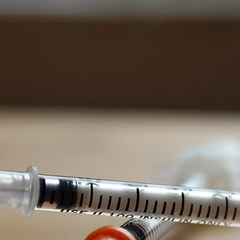
5 Ways To Combat Pharma Talking Points with Just the Facts
12 Aug 2022, 6 a.m. in #insulin4all USA, Global Stories, News & Statements by T1International
Misinformation about diabetes and insulin is all too regularly spread in both the media and on social platforms. In this post, we outline 5 of the most common talking points used to explain away price gouging and how we can use the facts to overcome this narrative.
1) “Insulin and other drugs are expensive because of the need for innovation through research and development!”
Reducing the price of insulin will not mitigate or prevent innovation, research, and growth in the pharmaceutical industry because public citizens and taxpayers shoulder a significant part of this investment.
As much as 40% of research and development costs are funded through public investment and universities, which then pass the drugs to pharmaceutical companies who end up holding the patents and profiting from them.

How much money does Big Pharma invest in research and development? Significantly less than they do marketing the same drugs to patients and the public. In 2020, Eli Lilly spent more on marketing and sales ($6.12 billion) than they did in research and development ($6.08 billion). Not to mention, the pharmaceutical industry is one of the largest and most influential lobbying operations in the world, spending $356.6 million in 2021 alone.
2) “Just use a Patient Assistance Program to help you afford your insulin!”
The so-called ‘assistance programs’ developed by companies such as Eli Lilly are deliberately complicated and labyrinthian systems designed to be unusable for most patients who need them.
Even if these programs were effective, they are not guaranteed to exist in the long-term, and can be canceled at any time. This holds patients hostage who need life saving medicines, rather than creating real and far-reaching solutions.

Instead of creating more programs, companies could simply lower the list price of insulin. However, by writing off patient assistance programs on their taxes, the pharmaceutical industry financially benefits from their alleged ‘charity.’
3) “It’s not Big Pharma’s fault. PBMs are the real problem!”
While PBMs (Pharmacy Benefit Managers) are an integral part of the prescription drug ecosystem, the leading cause of high insulin prices are a result of the manufacturers themselves. Analysis of the drug industry shows that manufacturers retain nearly two-thirds (68%) of every dollar spent on prescription drugs. PBMs retain only 5%, over ten times less than Big Pharma.

Finger-pointing is a known tactic within the healthcare industrial complex. Because Big Pharma continues to blame PBMs and PBMs continue to blame Big Pharma, no one gets held accountable. At T1International, we know how important it is to have a target in advocacy. We acknowledge that while the whole system is broken, the pharmaceutical companies are at the top of the supply chain and make the most profits, so therefore should be the first to be held accountable.
Elizabeth Pfiester, Executive Director of T1International notes, “Ultimately, the Big Three could decide to lower insulin costs tomorrow and retain a healthy profit. They have direct control over their own actions within the market, and influence over the structure of the market as a whole.”
4) “Just use cheaper or older forms of insulin, like NPH or mixed insulin!”
Patients should have the agency and power to use the type of insulin that is best for them and their body. No corporation should be able to dictate what is affordable to people to achieve a healthy life.
Forcing lower income patients to switch to non-analogue or older insulin creates a two-tiered system where the rich get better insulin and the poor are forced to use the older, and often more problematic, formula. Overall, newer insulins and analogues have proven to lead to better health outcomes and increases in quality of life across the board.

Even Big Pharma agrees that the newest insulins are superior. Dr. Todd Hobbs, the chief medical officer of Novo Nordisk in North America stated that, “We clearly think the newer versions are more close to what the body would do on its own.” Dr. Hobbs goes on to say that “prescription versions are better and safer, because they make it easier for patients to avoid wild fluctuations in blood sugar.”
5) “Companies exist to make a profit and we should not expect them to provide insulin for free!”
When insulin was discovered 100 years ago, the patent was sold for a single dollar so that it could be available and affordable to all. Today, a vial of insulin in the United States costs as much as $300 and worldwide, people are being forced to spend 60% or more of their income in insulin and diabetes supplies in some cases.
There is a difference between retaining healthy profits on a product and price gouging a life-sustaining medication, especially when profit-margins for pharmaceutical companies are in the billions. Global insulin production has been monopolized by three companies, who currently control over 90% of the market. In a healthy market, competition means prices go down. In the insulin market, prices have gone up - sometimes in lockstep with one another - which means that this is not a fair and competitive market.

On average, a vial of insulin costs $6 to produce. Insulin manufacturers could divide their prices by ten and still see margins as large as five times the cost per vial.
How can I use facts to combat Big Pharma and overcome narrative barriers on the internet?
Start by educating your family and community by using resources on our website such as this post. Spread the word in person and online.
Join the pharma-free fight for #insulin4all by donating or taking action. There are a number of ways to get involved, including our Chapter Network, Global Advocacy Network, or Digital Advocacy Program. We look forward to advocating the truth with you.










